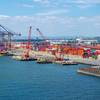Navigating a Safe Future for Us and Our Marine Environment
Navigating our oceans safely is always at the center of our maritime operations, whether it’s while deploying instrumented moorings, weighing up to tens of tons and measuring multiple kilometers in length, or working in remote, ice-packed regions.
World Maritime Day 2024 (September 26) – 50 years since the SOLAS convention was adopted – is reflecting on how we continue to navigate a safe maritime future. It’s a course we need to chart together, as an industry.
As a research organization focused on understanding and protecting our ocean, a key part of that safe maritime future is keeping the environment we operate in safe. Coming from a small British island, St Helena, I’m very aware of the risk to island communities from rising sea levels and more extreme weather events, resulting from climate change.
As an institute, we’re here to understand these complex dynamics to help protect the ocean and its ability to continue to sustain us, whether that’s as a route for more than 90% of global trade, as a major source of food or as the engine of our climate systems.
It’s a wider challenge that all in the maritime sector face as we seek to reduce the environmental impact of our vessels and vessel systems.
At the National Oceanography Centre (NOC), we’ve a goal to have net zero emission operations by 2040, 10 years ahead of wider UK net zero goals. It’s a tough challenge but one that we’re keen to tackle.
In collaboration with the UK’s Natural Environment Research Council (NERC), we’ve been conducting trials of hydrotreated vegetable oil (HVO) as an alternative fuel for our two research vessels, the RRS James Cook (delivered 2006) and the RRS Discovery (delivered 2013).
The fuel we use is a major part of our carbon footprint. But there are challenges to finding alternatives. One is cost. HVO is a great alternative to the low sulphur marine gas oil we otherwise (LSMGO) use. It’s one of the more stable biofuels under the conditions we operate in, which range from high temperature regions to the Arctic. HVO, by the way it is processed, removes moisture and, therefore, reduces bacteria growth, so it doesn’t degrade over time. It’s also a “drop in” fuel, so we don’t need to alter our engines at all. While there’s a small drop in calorific value, we have found it to be negligible.
But HVO costs substantially more than the LSMGOs we otherwise use. We’re talking almost three times as much.
There’s also a wider challenge. We’re a small part of the global maritime fleet, one which is more likely to dock in a remote port like Punta Arenas or Nuuk in Greenland than a major hub where alternative marine fuels are more available.
That lack of access to infrastructure is a challenge that limits our ability to use these fuels. We have been able to take on HVO in Aberdeen, Scotland, as well as via pipeline and other locations by road tankers but for our next UK visit, which will be to Southampton, we have had to consider options including, again, road tankers to get the fuel to us or a bunker barge to bring it round from the Thames.
In addition to that, there are a number of alternative fuel options – LNG, ammonia, methanol, hydrogen – but no clear indication which will prevail, this again limits what is available where. These fuels are also for retrofits or new builds.
We’re also looking at a hybrid battery solution which would enable us to run on just one engine efficiently, at, for example 90% load, instead of two at 60%, while holding station using dynamic positioning and performing science activities. Running one engine would reduce the fuel load, increase the time between engine overhauls for the less used engines, and reduce component wear as the engines would be running at a more optimal load. When we’re delivering more power than we need, that excess power can then be banked back into our batteries in a virtuous cycle.
To install batteries comes with challenges, one being finding the space for them and the second being their weight and how that impacts stability. Our studies so far suggest it’s feasible.
However, long-term certainty over our ability to invest and what we invest in, whether that’s types of fuel or alternative power sources, are challenges that we and many – including those with the ability to build refueling infrastructure – face in this environment.
It’s not just hardware that impacts our footprint. Marine planning, or where we go and when, can also help. We look at our science expeditions and make sure we have fewer stops between them, that one ends where another can start, but also weather routing, so we’re more efficient and the ship is concentrating on science days not transit time.
There are other quick wins we’ve already taken, like converting to LED lighting onboard, using frequency converters to reduce load use on items like pumps, and even having bicycles on board that staff can use when dockside for lower-footprint travel. The science teams also ensure freezers and laboratories are turned off when not in use.
But with vessels that are 10-15 years old, there are limitations on what we can do, which is another challenge many others face.
Of course, it’s not just all about our ships and maritime operations. Across our wider organization, other initiatives include converting the roof of our Southampton site to Zinc, enhancing the energy efficiency of the building, using 100% recyclable materials, increasing the number of electric car charge points, improving the efficiency of our laboratories and gaining IOS14001 environmental management accreditation.
Overall, we have a commitment to sustainability and environmental responsibility and we are fully committed to the journey we are on to decarbonize shipping, underpinning how we operate in a way that’s safe towards the environment we aim to help preserve.













